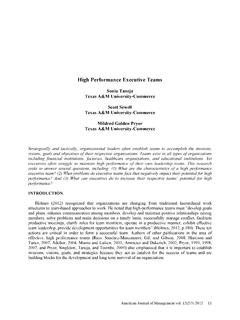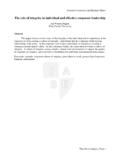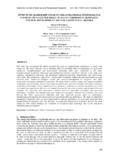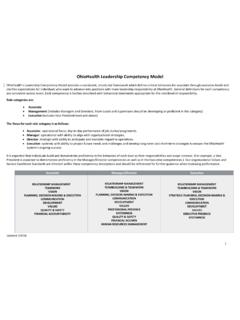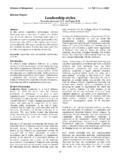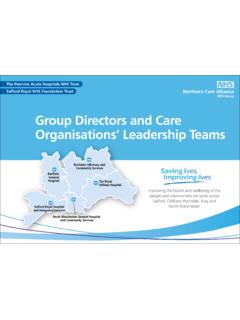Transcription of Leaders and the Leadership Process - …
1 Judith Campbell s Chapter Summaries & Reflections of: Leaders and the Leadership Process By Jon L. Pierce and John W. Newstrom Submitted for Clemson University s I LEAD! Program 12-15-09 Prologue Perspectives on Leadership From Homer s Odyssey By Fred A. Kramer (University of Massachusetts) Summary This article discusses the Leadership roles demonstrated by two characters in Homer s Odyssey. Mentor and Odysseus exhibited good Leadership by demonstrating Warren Bennis four competencies that Leaders must display. The four competencies are: management of attention through vision; management of meaning through communication; management of trust through reliability and constancy; and management of self through knowing one s skills and deploying them effectively.
2 Kramer discusses how the first three competencies are deeply related. A leader must have a vision and be able to communicate it to others. Not only this, they must be trustworthy and reliable. Kramer suggests the last competency, management of self, should supercede the others. In order for a leader to exhibit the first three competencies, he or she must have a strong sense of self-regard. Leaders should know their strengths and compensate for their weaknesses. According to Kramer, the main lesson of the Odyssey is that each of us should undertake our own journeys into self awareness and self-understanding. Reflection I agree with the last point made by Kramer on how important it is for Leaders to undertake their own journeys into self awareness and self understanding.
3 In my experience, the Leaders I have respected have all been very confident and self-assured individuals. Before they could communicate their vision, they had to know who they were and where they wanted to go in life. By having self-confidence, they were successful in building trust and communicating the meaning of their vision to others. Chapter 1 Reading 2 On the Meaning of Leadership By Jon Pierce and John Newstrom (University of Minnesota Duluth) Summary This article broadly covers the many different definitions and theories of Leadership . There are scholars who believe Leadership is a psychological phenomenon, that is, a leader is one who has specific personality and demographic traits. On the other hand, there are scholars who see Leadership as a sociological phenomenon, meaning a leader is the outcome of a combination of people, groups, and the needs of a situation.
4 The article then lists the several different approaches to define Leadership from the book Bass & Stogdill s Handbook of Leadership . The book defines Leadership as an interaction between two or more members of a group that often involves a structuring or restructuring of the situation and the perceptions and expectations of the members. The article authors state that most students view it as a sociological phenomenon (a Process ) involving the intentional exercise of influence exercised by one person over one or more other individuals, in an effort to guide activities toward the attainment of some mutual goal, a goal that requires interdependent action among members of the group. The article also lists several additional conceptualizations and uses of the Leadership concepts such as self- Leadership , servant Leadership , strategic Leadership , and coleadership.
5 The authors concluded by discussing the emerging Leadership role that helps people attain self- Leadership . It represents the transformation from the follow me leader to the leader who focuses on leading other to lead themselves. Reflection I thought the article did a good job of summarizing the many definitions of Leadership . I agree that Leadership takes many forms and that everyone can be a leader. The last bit of the article discussed the uses of Leadership and talked about self-learship, coleadership, and servant Leadership . I believe it s important to first have self- Leadership in order to be a good example for those one is trying to influence. Additionally, coleadership is vital for achieving long-term results.
6 And servant Leadership is very effective when you are attempting to build trust. I think my style of Leadership is more of a servant leader. I love serving others and influencing people to do good. I agreed with the point in the article of the importance of Leaders to engage in leading others to lead themselves. Chapter 2 Reading 7 Trust in Leadership and Team performance : Evidence from NCAA Basketball By Kurt T. Dirks (Simon Fraser University) Summary The essence of the article regards the relationship between trust in Leadership and team performance . There has been little empirical research done on the topic but the purpose of the article is to address two specific issues: 1) Does trust in a leader affect team performance ?
7 And 2) Does trust in Leadership mediate the relationship between past and future team performance ? Dirk defines trust as an expectation or belief that the team can rely on the leader s actions or words and that the leader has good intentions toward the team. In the article, Dirk describes the results of researching trust in Leadership by looking at NCA basketball teams. He found that trust in the leader has an affect on team performance (however, trust in teammates was not significant). Furthermore, the evidence suggested that researchers should consider trust as having the potential to be both an outcome and a determinant of organizational achievements. Lastly, Dirk suggests that higher levels of perceived vulnerability may increase the impact of trust in Leadership on team performance .
8 Reflection I believe trust is vital in all working relationships. I am not surprised by Dirk s findings that state trust in the leader has an affect on team performance . From my experience with group projects, I realized the importance of having/being a good project leader and building up trust with the group so that we could perform well on our assignment. If we did not trust in our group leader to help us complete our project, many of us ended up working on our own and not achieving the better results we would have if we had worked together. Chapter 3 Reading 9 Leadership : Do Traits Matter? By Kirkpatrick and Locke (University of Maryland) Summary The article discusses how traits alone are not sufficient for successful business Leadership , its how they take certain actions to be successful.
9 The authors list the six traits on which Leaders differ from nonleaders: drive, the desire to lead, honesty/integrity, self-confidence, cognitive ability, and knowledge of the business. Within the drive trait there are five aspects: achievement motivation, ambition, energy, tenacity, and initiative. The Leadership motivation trait can be seen in individuals who enjoy influencing others or being the greater authority. The effectiveness of a leader depends on the motivation for power. If it one desires power purely for the sake of dominating others, it usually results with dependent, submissive followers. However, if one is has a socialized power motive and wishes to us it as a means to achieved desired goals or a vision, and results in empowered, independent followers.
10 The other Leadership trait is self-confidence and projecting a constant image. Emotional stability and being able to control one s emotions in stressful times is important for Leaders to be effective. Another Leadership trait is cognitive ability, which involves being above average intelligence. Leaders with this trait have a strong analytical ability, good judgment, and the capacity to think strategically and multidimensionally. The last Leadership trait, knowledge of the business, is self-explanatory. People who are knowledgeable about a particular business or industry tend to be Leaders in their field. The authors of the article list three other traits with less explicit evidence of their importance to Leadership . These traits are charisma, creativity/originality, and flexibility.
